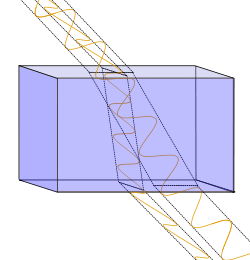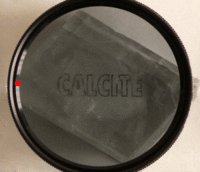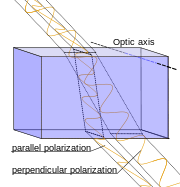Birefringence

_birefringence.jpg)

Birefringence, or double refraction, is the decomposition of a ray of light (and other electromagnetic radiation) into two rays (the ordinary ray and the extraordinary ray) when it passes through certain types of material, such as calcite crystals or boron nitride, depending on the polarization of the light. This effect can occur only if the structure of the material is anisotropic (directionally dependent). If the material has a single axis of anisotropy or optical axis, (i.e. it is uniaxial) birefringence can be formalized by assigning two different refractive indices to the material for different polarizations. The birefringence magnitude is then defined by
where ne and no are the refractive indices for polarizations parallel (extraordinary) and perpendicular (ordinary) to the axis of anisotropy respectively.[1]
The reason for birefringence is the fact that in anisotropic media the electric field vector  and the dielectric displacement
and the dielectric displacement  can be nonparallel (namely for the extraordinary polarisation), although being linearly related.
can be nonparallel (namely for the extraordinary polarisation), although being linearly related.
Birefringence can also arise in magnetic, not dielectric, materials, but substantial variations in magnetic permeability of materials are rare at optical frequencies. Liquid crystal materials as used in Liquid Crystal Displays (LCDs) are also birefringent.[2]
Contents |
Creation
While birefringence is often found naturally (especially in crystals), there are several ways to create it in optically isotropic materials.
- Birefringence results when isotropic materials are deformed such that the isotropy is lost in one direction (i.e., stretched or bent). Example
- Applying an electric field can induce molecules to line up or behave asymmetrically, introducing anisotropy and resulting in birefringence. (see Pockels effect)
- Applying a magnetic field can cause a material to be circularly birefringent, with different indices of refraction for oppositely-handed circular polarizations
- Self alignment of highly polar molecules such as lipids and some surfactants will generate highly birefringent thin films (see also Liquid crystal)
Examples of uniaxial birefringent materials
| Material | no | ne | Δn |
|---|---|---|---|
| beryl Be3Al2(SiO3)6 | 1.602 | 1.557 | -0.045 |
| calcite CaCO3 | 1.658 | 1.486 | -0.172 |
| calomel Hg2Cl2 | 1.973 | 2.656 | +0.683 |
| ice H2O | 1.309 | 1.313 | +0.004 |
| lithium niobate LiNbO3 | 2.272 | 2.187 | -0.085 |
| magnesium fluoride MgF2 | 1.380 | 1.385 | +0.006 |
| quartz SiO2 | 1.544 | 1.553 | +0.009 |
| ruby Al2O3 | 1.770 | 1.762 | -0.008 |
| rutile TiO2 | 2.616 | 2.903 | +0.287 |
| peridot (Mg, Fe)2SiO4 | 1.690 | 1.654 | -0.036 |
| sapphire Al2O3 | 1.768 | 1.760 | -0.008 |
| sodium nitrate NaNO3 | 1.587 | 1.336 | -0.251 |
| tourmaline (complex silicate ) | 1.669 | 1.638 | -0.031 |
| zircon, high ZrSiO4 | 1.960 | 2.015 | +0.055 |
| zircon, low ZrSiO4 | 1.920 | 1.967 | +0.047 |
Many plastics are birefringent, because their molecules are 'frozen' in a stretched conformation when the plastic is moulded or extruded.[4] For example, cellophane is a cheap birefringent material, and Polaroid sheets are commonly used to examine for orientation in birefringent plastics like polystyrene and polycarbonate. Birefringent materials are used in many devices which manipulate the polarization of light, such as wave plates, polarizing prisms, and Lyot filters.
There are many birefringent crystals: birefringence was first described in calcite crystals by the Danish scientist Rasmus Bartholin in 1669.
Birefringence can be observed in amyloid plaque deposits such as are found in the brains of Alzheimer's patients. Modified proteins such as immunoglobulin light chains abnormally accumulate between cells, forming fibrils. Multiple folds of these fibers line up and take on a beta-pleated sheet conformation. Congo red dye intercalates between the folds and, when observed under polarized light, causes birefringence.
Cotton (Gossypium hirsutum) fiber is birefringent because of high levels of cellulosic material in the fiber's secondary cell wall.
Slight imperfections in optical fiber can cause birefringence, which can cause distortion in fiber-optic communication; see polarization mode dispersion. The imperfections can be geometrically based, or a result of photoelastic effects from loading on the optical fiber.
Silicon carbide, also known as Moissanite, is strongly birefringent.
The refractive indices of several (uniaxial) birefringent materials are listed below (at wavelength ~ 590 nm)[3]
Fast and slow rays
| Propagation direction |
Ordinary ray | Extraordinary ray | ||
|---|---|---|---|---|
| Polarization | neff | Polarization | neff | |
| z | xy-plane |  |
n/a | n/a |
| xy-plane | xy-plane |  |
z |  |
| xz-plane | y |  |
xz-plane |  |
| other | analogous to xz-plane | |||
For a given propagation direction, there are generally two perpendicular polarizations for which the medium behaves as if it had a single effective refractive index. In a uniaxial material, rays with these polarizations are called the extraordinary and the ordinary ray (e and o rays), corresponding to the extraordinary and ordinary refractive indices. In a biaxial material, there are three refractive indices α, β, and γ, yet only two rays, which are called the fast and the slow ray. The slow ray is the ray that has the highest effective refractive index.
For a uniaxial material with the z axis defined to be the optical axis, the effective refractive indices are as in the table on the right. For rays propagating in the xz plane, the effective refractive index of the e polarization varies continuously between  and
and  , depending on the angle with the z axis. The effective refractive index can be constructed from the Index ellipsoid.
, depending on the angle with the z axis. The effective refractive index can be constructed from the Index ellipsoid.
Biaxial birefringence
| Material | nα | nβ | nγ |
|---|---|---|---|
| borax | 1.447 | 1.469 | 1.472 |
| epsom salt MgSO4·7(H2O) | 1.433 | 1.455 | 1.461 |
| mica, biotite | 1.595 | 1.640 | 1.640 |
| mica, muscovite | 1.563 | 1.596 | 1.601 |
| olivine (Mg, Fe)2SiO4 | 1.640 | 1.660 | 1.680 |
| perovskite CaTiO3 | 2.300 | 2.340 | 2.380 |
| topaz | 1.618 | 1.620 | 1.627 |
| ulexite | 1.490 | 1.510 | 1.520 |
Biaxial birefringence, also known as trirefringence, describes an anisotropic material that has more than one axis of anisotropy. For such a material, the refractive index tensor n, will in general have three distinct eigenvalues that can be labeled nα, nβ and nγ.
Positive or negative

Uniaxial birefringent materials are classified as positively (or negatively) birefringent when, for light directed perpendicularly to the optic axis, the refractive index of light polarized parallel to the optic axis is greater (or smaller, respectively,) than light polarized perpendicularly to the optic axis.[5] In other words, the polarization of the slow (or fast) wave is parallel to the optical axis when the crystal is positively (or negatively, respectively) birefringent.
Biaxial crystals are defined as positively (or negatively) birefringent when the slow ray (or fast ray, respectively) bisects the acute angle formed by the optical axes.[6]
Measurement
Birefringence and related optical effects (such as optical rotation and linear or circular dichroism) can be measured by measuring the changes in the polarization of light passing through the material. These measurements are known as polarimetry.
Birefringence of lipid bilayers can be measured using dual polarisation interferometry. This provides a measure of the degree of order within these fluid layers and how this order is disrupted when the layer interacts with other biomolecules.
A common feature of optical microscopes is a pair of crossed polarizing filters. Between the crossed polarizers, a birefringent sample will appear bright against a dark (isotropic) background.
For a fixed composition such as calcium carbonate, a crystal such as calcite or its polymorphs, the index of refraction depends on the direction of light through the crystal structure. The refraction also depends on composition, and can be calculated using the Gladstone-Dale relation.
Applications

Birefringence is widely used in optical devices, such as liquid crystal displays, light modulators, color filters, wave plates, optical axis gratings, etc. It also plays an important role in second harmonic generation and many other nonlinear processes.
It is also utilized in medical diagnostics. For example, needle aspiration of fluid from a gouty joint will reveal negatively birefringent urate crystals. Calcium pyrophosphate crystals, in contrast, show weak positive birefringence.[7] In ophthalmology, scanning laser polarimetry utilises the birefringence of the retinal nerve fibre layer to indirectly quantify its thickness, which is of use in the assessment and monitoring of glaucoma. Birefringence characteristics in sperm heads allow for the selection of spermatozoa for intracytoplasmic sperm injection.[8] Likewise, zona imaging uses birefringence on oocytes to select the ones with highest chances of successful pregnancy.[9] Birefringence of particles biopsied from pulmonary nodules indicates silicosis.
Birefringent filters are also used as spatial low-pass filters in electronic cameras, where the thickness of the crystal is controlled to spread the image in one direction, thus increasing the spot-size. This is essential to the proper working of all television and electronic film cameras, to avoid spatial aliasing, the folding back of frequencies higher than can be sustained by the pixel matrix of the camera.
Elastic birefringence
Another form of birefringence is observed in anisotropic elastic materials. In these materials, shear waves split according to similar principles as the light waves discussed above. The study of birefringent shear waves in the earth is a part of seismology. Birefringence is also used in optical mineralogy to determine the chemical composition, and history of minerals and rocks.
Stress induced birefringence
Isotropic solids do not exhibit birefringence. However, when they are under mechanical stress, birefringence results. The stress can be applied externally or is ‘frozen’ in after a birefringent plastic ware is cooled after it is manufactured using injection molding. When such a sample is placed between two crossed polarizers, colour patterns can be observed due to stress induced birefringence. The reason being that polarization of a light ray is usually rotated after passing through a birefingent material and the amount of rotation is dependent on wavelength.
Mathematical description
More generally, birefringence can be defined by considering a dielectric permittivity and a refractive index that are tensors. Consider a plane wave propagating in an anisotropic medium, with a relative permittivity tensor ε, where the refractive index n, is defined by  . If the wave has an electric vector of the form:
. If the wave has an electric vector of the form:
 (2)
(2)
where r is the position vector and t is time, then the wave vector k and the angular frequency ω must satisfy Maxwell's equations in the medium, leading to the equations:
 (3a)
(3a)
 (3b)
(3b)
where c is the speed of light in a vacuum. Substituting eqn. 2 in eqns. 3a-b leads to the conditions:
 (4a)
(4a)
 (4b)
(4b)
For the matrix product  often a separate name is used, the dielectric displacement vector
often a separate name is used, the dielectric displacement vector  . So essentially birefringence concerns the general theory of linear relationships between these two vectors in anisotropic media.
. So essentially birefringence concerns the general theory of linear relationships between these two vectors in anisotropic media.
To find the allowed values of k, E0 can be eliminated from eq 4a. One way to do this is to write eqn 4a in Cartesian coordinates, where the x, y and z axes are chosen in the directions of the eigenvectors of ε, so that
 (4c)
(4c)
Hence eqn 4a becomes
 (5a)
(5a)
 (5b)
(5b)
 (5c)
(5c)
where Ex, Ey, Ez, kx, ky and kz are the components of E0 and k. This is a set of linear equations in Ex, Ey, Ez, and they have a non-trivial solution if their determinant is zero:
 (6)
(6)
Multiplying out eqn (6), and rearranging the terms, we obtain
 (7)
(7)
In the case of a uniaxial material, where nx=ny=no and nz=ne say, eqn 7 can be factorised into
 (8)
(8)
Each of the factors in eqn 8 defines a surface in the space of vectors k — the surface of wave normals. The first factor defines a sphere and the second defines an ellipsoid. Therefore, for each direction of the wave normal, two wavevectors k are allowed. Values of k on the sphere correspond to the ordinary rays while values on the ellipsoid correspond to the extraordinary rays.
For a biaxial material, eqn (7) cannot be factorized in the same way, and describes a more complicated pair of wave-normal surfaces.[10]
Birefringence is often measured for rays propagating along one of the optical axes (or measured in a two-dimensional material). In this case, n has two eigenvalues which can be labeled n1 and n2. n can be diagonalized by:
 (9)
(9)
where R(χ) is the rotation matrix through an angle χ. Rather than specifying the complete tensor n, we may now simply specify the magnitude of the birefringence Δn, and extinction angle χ, where Δn = n1 − n2.
See also
- Cotton-Mouton effect
- Crystal optics
- John Kerr
- Periodic poling
- Dichroism
References
- ↑ Eric Weisstein's World of Physics on Birefringence
- ↑ The Science of Color, by Steven K. Shevell, Optical Society of America. Published 2003. ISBN 0444512519
- ↑ 3.0 3.1 3.2 Elert, Glenn. "Refraction". The Physics Hypertextbook. http://hypertextbook.com/physics/waves/refraction/.
- ↑ The Use of Birefringence for Predicting the Stiffness of Injection Moulded Polycarbonate Discs
- ↑ Brad Amos.Birefringence for facetors I : what is birefringence? First published in StoneChat, the Journal of the UK Facet Cutter's Guild. January-March. edition 2005
- ↑ Page 509 in:McClatchey, Kenneth D. (2002). Clinical laboratory medicine. Philadelphia: Lippincott Wiliams & Wilkins. ISBN 0-683-30751-7. [1]
- ↑ Hardy RH, Nation B (June 1984). "Acute gout and the accident and emergency department". Arch Emerg Med 1 (2): 89–95. PMID 6536274.
- ↑ Gianaroli L, Magli MC, Ferraretti AP, et al. (December 2008). "Birefringence characteristics in sperm heads allow for the selection of reacted spermatozoa for intracytoplasmic sperm injection". Fertil. Steril. 93 (3): 807–13. doi:10.1016/j.fertnstert.2008.10.024. PMID 19064263.
- ↑ Ebner T, Balaban B, Moser M, et al. (May 2009). "Automatic user-independent zona pellucida imaging at the oocyte stage allows for the prediction of preimplantation development". Fertil. Steril. 94 (3): 913–920. doi:10.1016/j.fertnstert.2009.03.106. PMID 19439291.
- ↑ Born M, and Wolf E, Principles of Optics, 7th Ed. 1999 (Cambridge University Press), §15.3.3
External links
- http://www.olympusmicro.com/primer/lightandcolor/birefringence.html
- [2] Video of stress birefringence in Polymethylmethacrylate (PMMA or Plexiglas).
- Application note on the theory of birefringence (see no.14)
